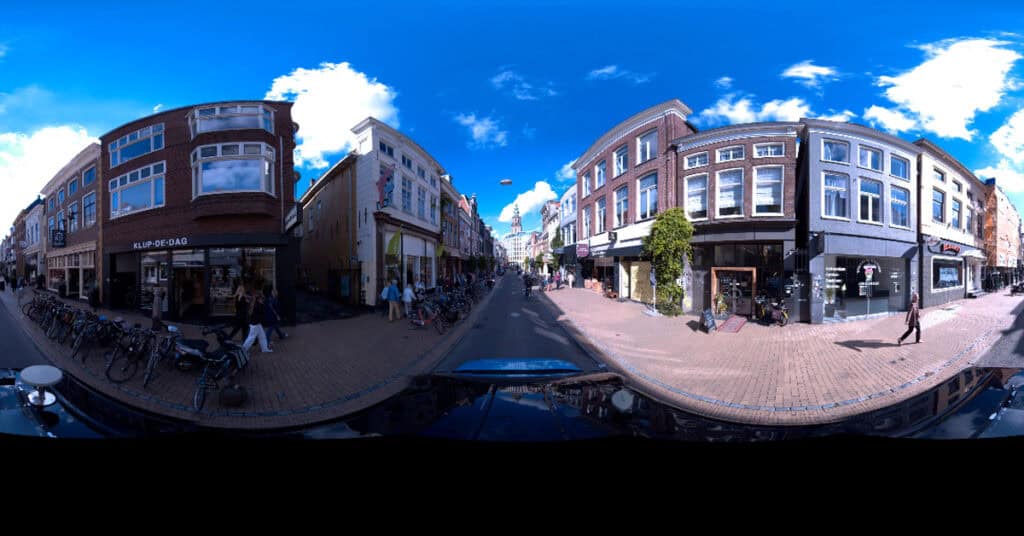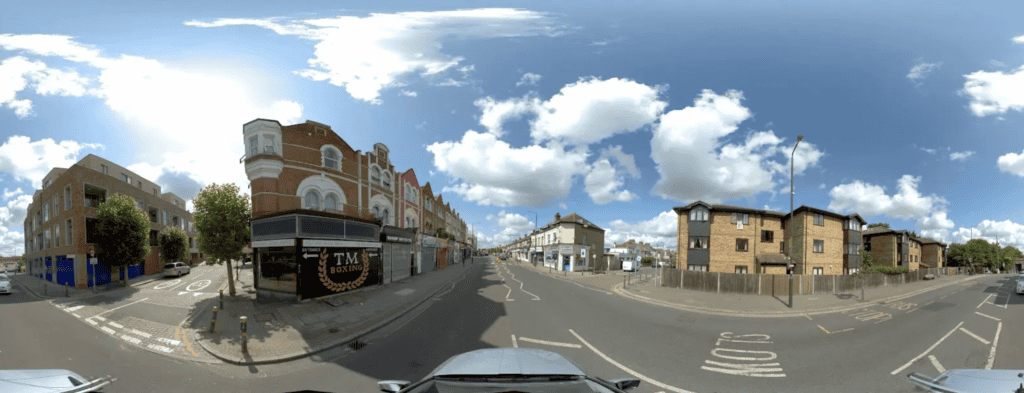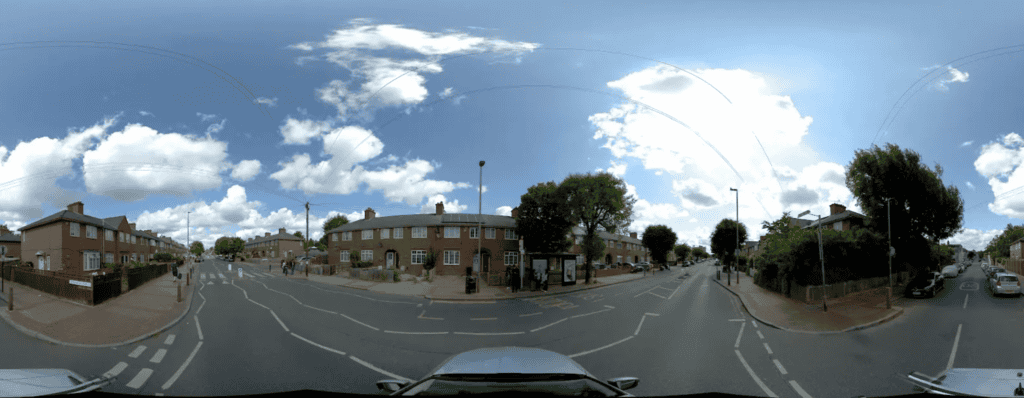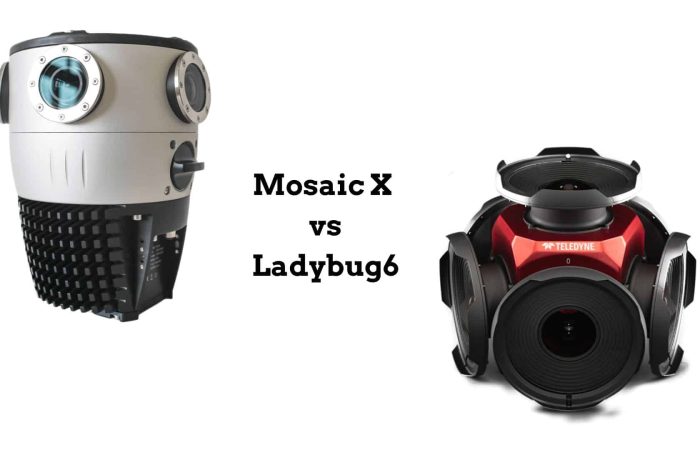It’s been two years since these two mobile mapping camera / camera systems were released. Let’s revisit what the industry is saying about each one. Check out the first article here.
What’s the difference: Ladybug6 vs. Mosaic X
What sets apart 2 of the biggest names in the mobile mapping camera sector?
With one – you get
- An all-in-one mobile mapping system that anyone can learn to operate quickly.
- A complete ‘out-of-the-box’ solution with integrated GNSS so that synchronization with external GNSS devices is not a problem.
- You can mix and match with additional sensors, creating the solution that works best for you.
- Non-proprietary data format means you can use the data in any workflow at no additional cost or complexity and no licensing fee structure.
To find out which one gives you all of these, keep reading.
Over the last few years the technology behind mobile mapping cameras has taken a significant leap forward, following several years of stagnation.
Today we will focus on two of the major contenders in the business. To learn more about a wider offering of well-known mobile mapping cameras – both some of the new entrants and some of the more established ones – check out this article here →
Several of the bigger players in the industry are Mosaic – producers of such cameras as the Mosaic 51 and Mosaic X camera systems – and Teledyne Flir producers of the range of Ladybug cameras (more about the difference between camera sensors and camera systems below).
Mosaic, founded in 2018 and one of the new players to the game, has already established itself as a major contender, even pushing other producers to make changes to their products after years of limited to conservative innovation.
Mosaic camera systems have been brought to the forefront of capturing high-resolution imagery, at scale, focusing on offering users an intuitive, all-in-one device for collecting street view imagery and geographical coordinates.
Teledyne Flir, historically, has developed the Ladybug3, Ladybug5, Ladybug5+, and Ladybug6. These cameras have set significant benchmarks in the industry over the last decades, embedding themselves among many standard mobile mapping systems.
However, Mosaic has not only met these benchmarks but also introduced unique advancements that distinguish themselves from the Ladybug models.
This article takes a look into the intricacies of these differences, providing a detailed comparison backed by technical data and customer feedback. This exploration will offer insights into why Mosaic systems are increasingly becoming the preferred choice for professionals in mobile mapping.
Historical Context and Evolution
The evolution of Mosaic in the mobile mapping industry is a story of consistent innovation, aimed at addressing the limitations of existing technology. Mosaic’s camera systems, including the Mosaic 51 and Mosaic X, are embodiments of this journey, introducing advancements that set new industry standards. These improvements include higher resolution imagery, enhanced durability, and more efficient data processing, reflecting a commitment to quality and user experience.
On the other hand, the Ladybug series has shown its own progression, with the Ladybug3, Ladybug5, Ladybug5+, and Ladybug6. Each iteration brought enhancements, but Mosaic’s development, especially with the Mosaic X, took a different route. Focusing on a more compact design, standalone functionality, and exceptional image quality, the Mosaic X camera system represents a leap in mobile mapping technology.
Technical Comparison: Mosaic vs. Ladybug
The following information is based on a comparison of the technologies as discovered from online publications as well as freely provided feedback from users of the various devices.
Camera Resolution and Image Quality
Mosaic camera systems, particularly the Mosaic 51 and Mosaic X, offer superior resolution compared to the Ladybug series. Mosaic camera systems feature a 12.3K and 13.5K resolution respectively, surpassing the Ladybug5’s 8K resolution.
After years of stagnation regarding the resolution of the LB cameras, the newly released Ladybug6 camera now achieves 12K resolution as well, although as any good photographer will tell you, numbers are not necessarily the end all be all of image quality.
| Resolution | Ladybug5 | Mosaic 51 | Ladybug6 | Mosaic X |
| Panoramic Image | 30 MP | 75.5 MP | 72 MP | 91.2 MP |
| Dimensions (WxH) | 8,192 x 4,096 = 33.5 MP | 12288 x 6144 = 75.5 MP | 12,288 x 6,144 = 75 MP | 13504 x 6752 = 91.2 MP |
To learn more about what resolution is and is not and many of the factors and components that lead to ‘good image quality’ check out this article here.
Image from the Ladybug6 (below)

Panoramic image from the Ladybug6 camera showing poor color balance, bad dynamic range, dark shadows and blown out highlights. Image source
Images from the Mosaic X camera system (below)

The Mosaic X camera system demonstrating color balance, high dynamic range, high definition within shadows and no blown outs.

The Mosaic systems deliver sharper and more detailed imagery, essential for precise mapping and data analysis. Image source (Mosaic X camera data from London 2023).
Spatial Accuracy vs Ground Sample Distance (GSD)
Ladybug6 advertises “72 Megapixel images with a spatial accuracy of +/- 2 mm at a 10-meter distance.”
This term “spatial accuracy” is misleading as it suggests each pixel represents a 2 mm area on the ground, which is not standard industry terminology.
Instead, in standard terms, the camera’s actual performance under ideal conditions corresponds to a “ground sample distance” (GSD) of 4 mm per pixel. “GSD” refers to the physical area on the ground covered by each pixel in an image, and is the conventional way to describe this aspect in the imaging industry.
Teledyne, the manufacturer, uses the term “spatial accuracy of +/- 2 mm” rather than GSD, seemingly to suggest a higher level of precision.
In contrast, the Mosaic X, offering 13.5K resolution panoramas, effectively uses its pixels and field of view to achieve a superior spatial resolution—approximately 10 percent better than that of the 12K resolution panoramas of the Ladybug 6.
| Ladybug5 | Mosaic 51 | Ladybug6 | Mosaic X | |
| Angular FOV | Vertical: ~117.4° Horizontal: ~85.9° | Vertical: 124° Horizontal: 96° | Vertical: ~113.4° Horizontal: ~94.8° | Vertical: 109°Horizontal: 80° |
Image Overlap and Pixel Efficiency
Mosaic cameras are designed to use pixels more efficiently, with a smaller overlap between camera views. This design results in higher-quality stitched images.
In contrast, Ladybug cameras tend to have a wider field of view with a bigger overlap, which can lead to inefficient pixel usage and lower overall image quality.
Industry Feedback and Observations
Recent industry feedback about the Ladybug6 camera system has highlighted several concerns and observations:
Mosaic’s Resolution Advantage
The Mosaic X camera systems boast a resolution higher by more than 1000 pixels. This substantial difference in resolution results in sharper, more detailed imagery, positioning Mosaic as the preferred choice for high-precision mapping tasks.
What this means for the user:
Higher resolution, combined with sharper, more detailed imagery means that the end-user of the data is able to see more details, more clearly and zoom in more closely.
This also means that when running AI/ML algorithms on Mosaic imagery, there is a higher chance of correctly identifying and classifying the desired objects
Customer Insights and Preferences
As stated earlier in this article, the following feedback has been provided to Mosaic employees over the past year from current Ladybug users. Several customers have expressed a desire to transition away from Ladybug cameras, citing a range of reasons:
Minimal Improvements: Some customers noted that the progression from Ladybug5 to Ladybug6 lacked significant technological advances, which didn’t meet their evolving needs.
Camera Design and Performance: Concerns were raised about the geometric design of the Ladybug cameras, impacting their overall performance. Additionally, the lightweight nature of these cameras sometimes led to practical challenges, such as becoming entangled in tree branches due to its irregularly-shaped design.
On the left: Mosaic X camera system. On the right: Ladybug6 camera.
The housing of the Ladybug6 camera leaves the lenses exposed and this can mean that when passing under low-hanging foliage, the cameras are prone to getting caught in tree branches.
Customer support and response time: There is more to any piece of hardware and software. There is also customer support, whether on the pre-sales side or after purchase. Mosaic customers have consistently provided positive feedback regarding the quality and speed of support.

“We’ve been pleased with your quality of product and service, really your level of service stands out amongst our other experiences.”
Dusty Birge, FF.ai
Mosaic’s Technological Edge
Mosaic’s camera systems offer distinct technological advantages that enhance user experience and data utility:
Open Format Data Manipulation
Mosaic’s open format allows for more versatile and user-friendly data manipulation. This flexibility is crucial for custom applications and diverse mapping needs.
The camera captures and stores data in 6 video file containers (mp4) which then form a flexible starting point for nearly any post processing need.
Many Mosaic customers enjoy creating a stitched 360º video so that they can quickly move through their construction sites, road works, or rural utility routes with ease.
Others choose to stitch and extract geo-referenced panoramas which are then ready to be loaded into most GIS software or map viewers with high geographical accuracy.
However, those wishing to colorize point clouds with the data will find that non-stitched images offer greater results. Check out various Mosaic customers who are colorzing point clouds, using their preferred LiDAR solution and workflow.
→ Dymaxion with the Mosaic 51 and Hesai PandarXT LiDAR
→ Kavel 10 with the Mosaic X camera system and RIEGL VUX Scanner
Users looking to utilize the data within photogrammetry software for 3D modeling also benefit from having non-stitched images, as stitched panoramas are never an ideal source of imagery for such procedures.
The Mosaic X offers a significant advantage in terms of data processing. Its use of a nonproprietary file format allows for greater flexibility, as users can employ a variety of software tools for stitching and photogrammetry without additional costs.
The Ladybug6 utilizes a proprietary format, requiring a specific license for data processing. This can add extra costs and limitations in terms of software compatibility. Additionally, post-processing is necessary for color and exposure correction, as the initial output tends to be flat with inadequate exposure.
User-Friendly Interface and Design
The Mosaic X camera systems are designed for ease of use, with control possible via tablets or smartphones, making the process more accessible and convenient for users in the field, as well as more economically efficient.
This design reduces or essentially eliminates the need for lengthy and costly training.

“Remarkably, we required almost no training to use the Mosaic camera or to instruct our clients in its usage,”
reported Iwu Emmanuel, a Mosaic customer from Mapersive in Morocco.
This increases the efficiency of the devices in several ways;
- Less time on boarding means an initial cost savings that many MMS require (such as several days of a paid demo from the producer)
- An easier interface means more employees within the company can confidently work with the camera
- Only one person is needed to both safely drive the vehicle and control the camera system, reducing normal mobile mapping teams from 2 to 1
- Control and real-time viewing of images via smartphone, tablet or laptop reduces costs associated with the standard workstation that many larger mobile mapping systems, including those deploying the Ladybug cameras require for controlling, viewing and storing data.
Image Quality and Efficiency
Mosaic’s camera systems demonstrate a superior approach to image quality and efficiency:
Triggering and Auto Exposure
The Mosaic X camera system exhibits a more responsive auto exposure mechanism. Unlike its counterpart, it can adjust exposure settings more rapidly, ensuring quicker adaptation to varying lighting conditions. This feature is particularly useful in environments where lighting conditions change frequently and unpredictably.
The Ladybug6 camera triggers approximately twice per second, taking about four frames (roughly 2 seconds) for auto exposure to adjust. This slower response can impact image quality in rapidly changing lighting conditions, making the Mosaic X a more adaptable choice in such scenarios.
Efficient Pixel Use and Smaller Overlap
Mosaic cameras utilize pixels more efficiently with a smaller overlap between images. This results in clearer and more consistent panoramic images, enhancing the overall mapping quality.
Reduced “Ghosting” and Superior Stitching
Ladybug cameras sometimes struggle with “ghosting” due to their overlap technique. Mosaic addresses this with a more advanced stitching technique, reducing image artifacts and improving the clarity of the final image.
Fewer Artifacts in Mosaic Data
Compared to Ladybug, Mosaic’s data shows fewer artifacts, a testament to its superior image processing and camera design.
Other considerations
Integration with RIEGL Systems
For RIEGL customers, the choice between Mosaic X and Ladybug6 can be significant. The Mosaic X offers greater flexibility for those not using RiProcess for photo processing, allowing for a wider range of software options without being tied to a specific processing tool. This flexibility can be a crucial factor for users seeking a more versatile and less restrictive imaging solution.
Economic Efficiency
Easily Replaceable Lens Covers
The Mosaic X stands out in terms of maintenance and long-term cost-effectiveness. Its easily swappable lens covers not only reduce the cost of repairs but also add to the convenience of maintaining the camera in optimal condition.
The absence of replaceable lens covers on the Ladybug6 means that any damage to the lens could necessitate a complete replacement, potentially leading to higher maintenance costs over time.
No Onboard Computer Needed
The elimination of an onboard computer to control, view and store data from the camera itself reduces the costs associated with setting up a full mobile mapping camera system in the vehicle. It also means that Mosaic camera system users can get up and go – easily moving from location to location, making use of various vehicles (including rentals), depending on the job at hand.
Camera Sensor vs Camera System: Mosaic’s Standalone Advantage
As mentioned at the top, there is a difference between ‘camera sensor’ and ‘camera system’. Many of the devices currently on the market are simply camera sensors. Here’s the difference and why it matters.
The Distinction
Ladybug cameras (among several other mobile mapping cameras) are solely camera sensors, requiring additional devices to actually do anything at all. In contrast, Mosaic camera systems are fully-featured, all-in-one, standalone devices, offering a more integrated and efficient solution.
The Mosaic 51 and Mosaic X mobile mapping camera systems contain:
- Onboard storage
- Internal GNSS (with multiple options for plug-and-play external GNSS/INS)
- Onboard GPU/CPU
Benefits of Mosaic’s Standalone Camera Systems
One of the major differences in equipment is that video storage and GPS are integrated into one solution, making it very simple to build the equipment. We have also used Ladybug but we connected it to a separate laptop via USB and the connection was lost, so we could not use the data we were shooting, and we had to turn the power off and on to reconnect, which was inconvenient. The advantage is that it is stable without such incidents, and almost all functions can be used with the built-in WebUI without the need to develop or install a separate program. Developers can also easily develop with RestAPI.
Jinsoo Shin, TiLAB
Synchronization with GNSS for Increased Efficiency
We have owned 2 units of LadyBug5+ since 2018/2019. Since we have our own mobile mapping system, LadyBug cameras were never a priority. The main problem we faced was synchronization with our GNSS since the Ladybug is only the sensor. Very unstable timestamps caused lots of trouble and it took some time for us (and few new firmware’s) to solve the problems.
Last year we have decided to go with new system and Ladybug6 was not our obvious choice, rather the Mosaic X was our priority. The reason being that is has an onboard integrated GNSS – so synchronization with external GNSS is not a problem. I like the fact that this system is ready to use out of the box and this was important difference to LB6.
Michal Maciolek, Lehmann Partners
Reduced Equipment
Fewer devices are needed in the vehicle, simplifying setup and reducing clutter.
Lower Failure Risk
With fewer components, there’s a reduced risk of system failures, enhancing reliability.
Integrated Data Capture for Use “Out of the Box”
Mosaic systems can independently capture and store images, GPS coordinates, and extremely precise timestamps within their internal SSD.
For a list of current ‘out-of-the-box’ Mosaic intergrations, partner-led integrations and known custom integrations by Mosaic customers, visit this page.
Versatile Operation
They can function alone with a single operator or integrate into larger systems like RIEGL, Leica, or Trimble, or even custom-designed mobile mapping systems.
→ Check out the wide range of Mosaic customers and how they are using their camera systems as standalone devices or as part of their unique mobile mapping solutions here.
System Complexity
The Mosaic X was designed as a streamlined, single system. It integrates image capture, GNSS data, and timestamps into one SSD storage device, sufficient for more than one full day’s capture. This integration makes it user-friendly and efficient, ideal for extensive use without the need for constant oversight or additional equipment.
In comparison, the Ladybug6 system is a far more complex and fragile system, involving an intricate setup with numerous cables and additional components. This complexity can be daunting for new users and might require specialized operators, potentially increasing operational costs.
Conclusion
Mosaic’s camera systems have demonstrated technological superiority through higher resolution, efficient pixel use, and advanced stitching techniques, reducing artifacts and enhancing image quality. The standalone nature of Mosaic systems offers reliability, simplicity, and versatility, distinguishing them from competitors like Ladybug. Customer feedback underscores Mosaic’s commitment to innovation and user satisfaction. Looking forward, Mosaic remains dedicated to advancing mobile mapping technology, continually improving its systems to meet the evolving needs of the industry.
In summary, while both the Mosaic X camera system and Ladybug6 camera offer advanced imaging capabilities, they differ significantly in terms of responsiveness, processing requirements, system complexity, integration flexibility, and cost-efficiency. The Mosaic X has answered several distinct challenges users have faced in the past, making it a potentially more versatile and economical choice for a wide range of applications.
For more information related to the Mosaic camera systems, please contact us below.



